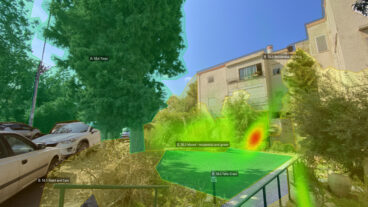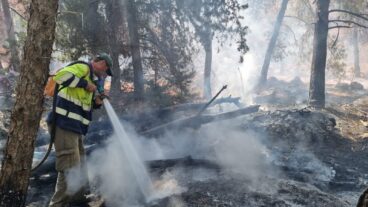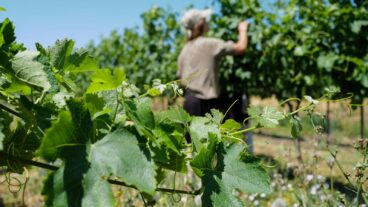Ran Nathan: We are going to establish this new field of research!
Building roads, logging and other activities in wooded areas in the US can cause the fragmentation of what was continuously forested land. This development can seriously affect the ecosystem, exposing birds to predators, for example, and putting animal and plant species at risk of extinction.
Israeli researcher Prof. Ran Nathan is pioneering a new field of research, Movement Ecology, that, by understanding how plants and animals move in space, could help preserve such forests as well as painting a picture of how global climate change is affecting our planet’s crucial biodiversity.
“I was a nature lover as a child,” says the 43-year-old Nathan, recipient of the 2005 Hebrew University of Jerusalem’s President’s Prize for Outstanding Young Researcher. “I grew up in Eilat, and I was very enthusiastic about reptiles. I always had many snakes.”
Snakes in the backyard didn’t bother Nathan’s parents, who encouraged his interests, sending him at the age of fourteen to the Environmental High School at Sde Boker the Negev Desert, near the grave of Israel’s first prime minister and Negev enthusiast David Ben Gurion.
“It was 1976, it was the first year of the school’s operation,” Nathan told ISRAEL21c. There were around thirty students in the school’s first class, and a major part of the curriculum was the field trips that taught the teenagers about both Israel’s ecosystems and greater global ecological questions. It was here that Nathan found a new interest: birds.
“I became a bird-watcher, a serious birder,” he says, getting up and moving over to his bookshelf to bring down his high school project on bird migration in Eilat, a lengthy and detailed work that took him three years and which, at first glance, looks like a masters’ thesis.
The Israeli Defense Forces were Nathan’s next home, more specifically the Golani combat unit, where he chose to spent an extra three years on top of the three years’ compulsory service. For the next two years, he worked at the Society for the Protection of Nature in Israel’s field school in the Golan in northern Israel. One of his achievements here was stopping the Israeli Air Force flying over the Gamla Nature Reserve “because of the Griffon vultures that breed there,” he explains. “The Air Force’s helicopters flying over was one cause of their low breeding rates.”
The Air Force acquiesced to his request and the vulture population in Gamla, the largest breeding colony in Israel, came back from the brink of extinction.
Nathan decided that in order to become a serious bird ecologist, he needed to study biology, which he did at undergraduate level at the Hebrew University; next, he planned to do a second degree in bird ecology. However, in 1992, his career took a detour.
“I went to Uriel Safriel, Hebrew University’s bird expert, and I asked him to supervise my project on birds for my masters,” he says. This was a few years after the devastating 1989 fire on Mount Carmel in the north of the country, which destroyed around 300 hectares (740 acres) of forest of Aleppo pine, the only pine species native to Israel. Safriel had been appointed head of the committee to restore the Mount Carmel reserve and he suggested that Nathan focus not on birds but on plants – and set him the task of developing the dynamic model of vegetation that the committee had decided was the way to accomplish the restoration of the forest.
“If we want to know the dynamics of the system, we must start with plants,” says Nathan. “I thought, ‘Well, I want to be a serious ecologist, not only a birder, so I should first study plants and get some knowledge about modelling.’ This is what I am doing now.”
Aleppo pine seeds are dispersed by the wind, so in order to see how the Aleppo pine forest could be restored, Nathan began working on models of how the wind actually assists in seed dispersal, and this has since become the focus of his research.
“I found it fascinating,” he says. The publication a few years ago in Science of a paper by leading ecologists stating their belief that there is ‘inherent uncertainty’ in this system, meaning that we can never really understand it or predict the way seeds will be dispersed, only spurred him on further, with the typical Israeli attitude when faced with someone telling them they can’t do something.
“When there is a big challenge, I get excited,” he grins.
In a paper he published, he used the Oscar-winning movie Forrest Gump, as a metaphor for this: “Conventional thinking was the wind is so chaotic that you can’t model it. In the opening shot of the movie, you see a feather flying chaotically, but suddenly it changes direction, and you get the impression that the movement is so organized,” he says. “The feather then lands on the shoe of this strange man sitting in the park. I think that this is what Robert Zemeckis [the director] was trying to say. It is chaos, but if you are Forrest Gump, it becomes ordered. This man can master chaos.”
Nathan decided that, like Forrest Gump, he would attempt to master the apparent chaos of seed dispersal.
Major shifts in science occur when an existing problem is looked at in a different way. Following his PhD, also at Hebrew University, Nathan attended Princeton University for postdoctoral research. He was focusing on long distance seed dispersal: seeds are dispersed immediately around a tree, but some also travel further, sometimes several kilometers, a phenomenon vital for a species’ survival. Short distance dispersal is fairly well understood, but there was very little data on how seeds made their way further afield.
Until that point, research into seed dispersal relied on experimental evidence collected by placing seed traps on the ground. Designing an experiment on long distance seed dispersal in North Carolina’s Duke Forest, funded by the US National Science Foundation, he and his team, which included atmospheric scientists as well as ecologists, raised their sights higher.
“We placed seed traps vertically on a tower up to twelve meters above the forest canopy,” he explains. “The hypothesis was that uplift by [the wind’s] updraft is a crucial component of long distance seed dispersal.” This hypothesis turned out to be correct.
Nathan’s discovery of the vital link between uplift and long distance seed dispersal placed him at the cutting edge of research in this field. He since discovered that the shedding of foliage by deciduous trees, which had not been studied before, is also a vital factor.
“Contrary to what it seems, in forests with foliage shedding there are stronger [wind] eddy currents which carry the seeds further,” he says, and this explains why trees wait until spring or fall to disperse seeds, despite the added risk that seeds will be eaten by predators.
In 2001, Nathan, who is married to Michal, a yoga teacher, and father to Oz, aged 18, Kesem,16, and Noga,8, returned to Israel from the US… coming home was always the plan, he says – and spent two years at the Life Sciences Department of Ben Gurion University of the Negev. In 2003, he came back to his alma mater, the Hebrew University, taking up the post of senior lecturer. He founded and heads the Movement Ecology Lab at the Department of Evolution, Systematics and Ecology, which is part of the university’s Alexander Silberman Institute of Life Sciences.
A leader in his field, Nathan, who is routinely asked to review papers for many international journals, including Science, Ecology, The Journal of Ecology and the Proceeding of the Royal Society of London, is taking this research in hitherto unexplored directions to examine all aspects of the movement of living organisms.
“This is the only lab in the world that is doing this,” he says of his multidisciplinary ecology lab, which brings together students with a multitude of interests, from bird migration and animal movement to the ecology of bat and insect communities, to look at all the ways animals and plants can move.
In September, Nathan will be leading an international research group in Movement Ecology under the auspices of the Hebrew University’s Institute of Advanced Studies. “We will have eight people, four from Israel and four from abroad, who will be studying full time for a year,” he enthuses. “We are going to establish this new field of research!”
The applications of research into long distance seed dispersal are wide-ranging, from understanding how genetically-modified crops may ‘invade’ plants in nearby fields, to examining forest fragmentation. Climate change models do not currently incorporate seed dispersal, he says, “especially long distance dispersal”, but this is a vital factor in our picture of the ecosystem, and how vegetation is moving and changing as the climate changes, and how the precious biodiversity of the earth can be conserved.
The President’s Prize for Outstanding Young Researcher, named for the late Prof. Yoram Ben-Porath, former president and rector of the Hebrew University, was “a total surprise,” says Nathan. “I didn’t expect it.”
The prize is not just an honour: it involves a monetary award, part for Nathan’s personal use and part for his laboratory. Say Nathan modestly, “I didn’t expect it, but it is very nice. It is a great honor.”
This is undoubtedly one scientist whom the wind will be carrying to ever-greater heights.












